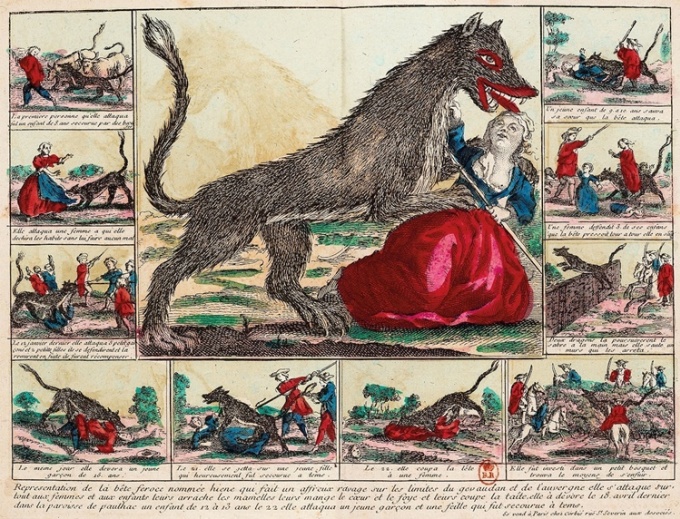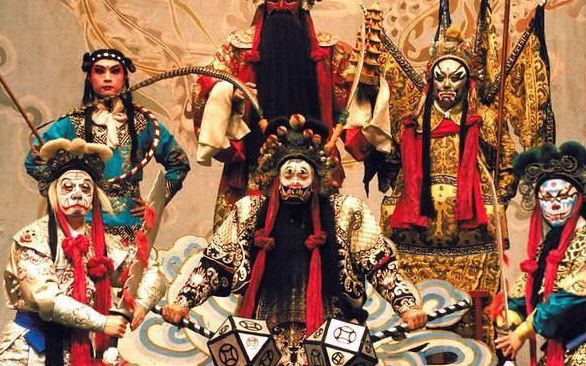The “werewolf” mystery that terrified France in the 18th century
One day in June 1764, Jeanne Boulet, a 14-year-old shepherd girl, brought her cattle to graze in the middle of a wooded valley near the River Allier, in the Gévaudan region, south-central France. The next day, Boulet’s wounded body was discovered, apparently from a wolf attack.
Boulet’s death was not unusual at the time. French children at that time often herded sheep or cattle alone and wolves were a constant threat to them.
But similar deaths to Boulet with numerous serious injuries were continuously reported afterwards. Whatever this deadly creature was, it was far more ferocious than the average wolf. Rumors of “werewolves” began to appear. Terrified people called this mysterious creature “la bete”, or “monster”.

The attacks of the “Werewolf”, “The Beast of Gévaudan”, depicted in an 18th century painting. Photo: Wikimedia Commons.
It terrorized the people of Gévaudan for three years, killing about 100 victims, although many sources put the total death toll at 300. Between 1764 and 1767, more than a hundred wolves were killed in the region. Gévaudan, but scholars are still trying to determine if they are indeed the culprits.
The county of Gévaudan is in the rugged Central Massif highlands, located between the Auvergne and Languedoc regions of France. This is the land of dense forests and plateaus that rain all year round. Gévaudan was once prosperous, but the wars of the 16th century devastated the rural economy. The local people became poor and lived mainly by raising cattle.
After Boulet’s death and dozens of other cases, the young shepherds regrouped in groups, but the beast did not flinch from their numbers. The brutal attacks continued, claiming the lives of most of the women and children. In the fall of 1764, rumors of the terrifying monster had spread beyond Gévaudan to all of France.
The beast became a nationwide obsession at the hands of the editor of the Courrier d’Avignon newspaper, François Morénas. The Anglo-French War ended in 1763, leaving Morénas in a state of “starvation”. Once highly successful with sensationalism, Morénas published stories about the Gévaudan monster in an attempt to increase the newspaper’s revenue and spread information about the creature throughout the country.
The attacks of the mysterious creature created terror, and the panic was further provoked by the dramatic accounts of reporters from the Courrier d’Avignon newspaper.
An article describes a monster with incredible speed. Another article says it has the eyes of the devil. Other writings assert that it possesses the intelligence of a “wise, mighty and good fighter”. As late as 1764, Morénas’ writings also compared the beast to the mythical Nemean Lion or other fearsome fabled monsters.
In addition to the gruesome description of the monster itself, the articles also quoted survivors’ accounts of encounters with it. In January 1765, a group of teenagers are said to have encountered the monster Gévaudan and fought back with sticks. In March of the same year, Jeanne Jouve fought to protect her three children from the beast’s attack. One of the three children, aged six, died from his injuries. One of the most famous is Marie-Jeanne Vallet, who fought the monster, stabbing it in the chest with a bayonet.
For some people, catching the monster will be a huge boost to their fame and career. Jean-Baptiste Duhamel, commander of the local military force, recruited thousands of men to help him hunt down the mysterious creature in the fall of 1764.
Based on accounts of the long black stripes on the monster’s back, Duhamel speculated it was not a wolf, but a large cat. “This creature is a monster whose father is a lion, whose mother is unknown,” speculated Duhamel. But despite his best efforts, Duhamel still couldn’t catch it.
By early 1765, dramatic stories about the monster Gévaudan continued to attract the attention of King Louis XV. He richly rewarded the group of boys who fought the monster with a stick and gave the leader of the group free schooling. In March, the king sent royal hunters to trap the beast. A famous Normandy wolf hunter, Jean-Charles Vaumesle d’Enneval, is appointed to lead the quest, but he is also unsuccessful.
Worried about the fruitless hunt, King Louis XV sent his trusted bodyguard, veteran officer François Antoine, to undertake the task. On September 21, 1765, Antoine’s group killed a large wolf they believed to be the monster Gévaudan. The beast’s carcass was sent to Paris and Antoine was rewarded.
However, two months later, the “werewolf” reappeared and the attacks resumed. From December 1765 to June 1767, an additional 30 deaths were reported. Fear stalks Gévaudan once again, except this time the locals have to fend for themselves. Ashamed of their failure, the authorities showed no interest, and even the press lost interest.
On June 19, 1767, local hunter Jean Chastel shot and killed a large beast. Since then, the attacks stopped. Witnesses described the slain creature as wolf-like, but strangely had a “monstrous” head and a tricolor red, white, and gray fur that hunters had never seen on wolves before. this.
In the centuries that followed, a variety of explanations were offered for the cause of the gruesome deaths in the Gévaudan region. One of the causes has a supernatural origin: “Werewolves”. Science has ruled this out, but the legend persists for many years, perhaps because of the rumor that Chastel shot the beast Gévaudan with a silver bullet.
Conspiracy theorists have recently speculated that a serial killer may have committed the crimes in Gévaudan. This man trained wild animals to kill his victims on his behalf. However, most experts think the idea is too far-fetched.
The answer that received the most support came from the animal world. Many people think the monster could be a creature not of French origin, like a hyena. Biologist Karl-Hans Taake recently speculated the beast was a runaway male lion, whose immature mane looked strange to residents of rural France. According to Taake, the last lion died after ingesting poisoned bait that was placed all over the Gévaudan region.
Historian Jay M. Smith proposes a less bizarre theory: The mysterious creatures appear to be large wolves. Media distortions and national panic created the “monster of Gévaudan” and the hype that accompanies it.
A century after the last attack, Robert Louis Stevenson, author of “Hidden Island”, a popular teen adventure novel, passed through Gévaudan and described his own disappointment before the way the world is changing.
“This is the land of the unforgettable monster, Napoleon Bonaparte of the wolves.” Now that the railroad had arrived, “you may never again encounter an adventure worthy of its name,” he wrote.
The modern world may have crept into Gévaudan, but the monster’s true identity will most likely never be solved, bringing an air of perpetual mystery to this wilderness.
at Blogtuan.info – Source: danviet.vn – Read the original article here

